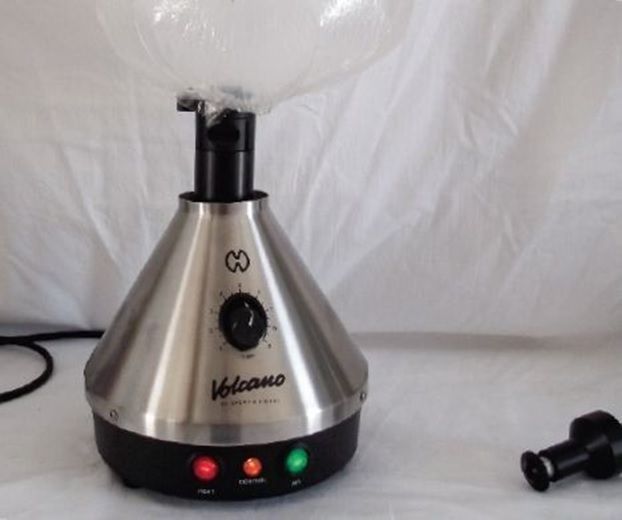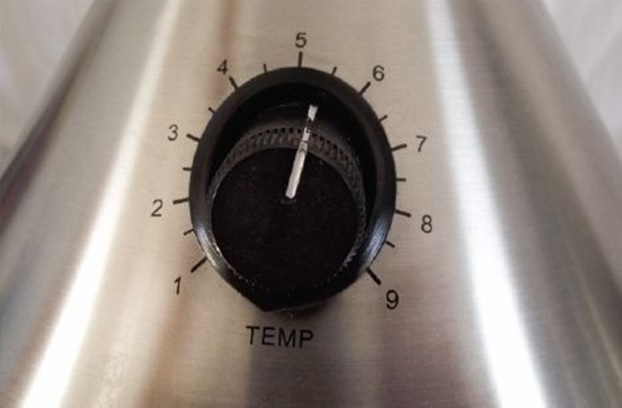
With a quality vaporizer, you are receiving 100% of the cannabinoids.
A much more efficient and precise method of inhalation is a specially designed-vaporizer. These units don’t actually burn the cannabis material, but instead, gently heat to set temperatures that release the cannabinoids as a mild vapor that can be inhaled.
A vaporizer does not use combustion, so none of the cannabinoids are consumed by flame, making a vaporizer very economical. With a quality vaporizer, you are receiving 100% of the cannabinoids from your herbal cannabis, as opposed to losing over half of the cannabinoids through combustion when smoking. Vaporizers are usually portable and can be carried with you, with some being small enough to place in your pocket. The non-portable types are larger, and ideally, you should purchase one that includes a variable temperature function that gives a more precise delivery of the cannabinoids. The ability to choose the temperature at which you vaporize will allow you to administer the cannabinoids you wish, and, whether your desire is to medicate or get high, this essential facility gives you total control. It is the higher temperatures involved in smoking that are responsible for the production of carcinogenic hydrocarbons, and these are almost completely eliminated by the use of a quality vaporizer, as the lack of combustion suppresses the formulation of the health-damaging compounds. In 2007, a study of vaporization conducted at the San Francisco General Hospital concluded:
“Vaporization is a safe and effective cannabinoid delivery mode for patients who desire the rapid onset of action associated with inhalation while avoiding the respiratory risks of smoking, as they significantly reduced the intake of gaseous combustion toxins, including carbon monoxide.”22
The vaporizer used by the 18 participants in the study was a Volcano Vaporizer, manufactured by Storz & Bickel, which was chosen for its reliability, efficiency, and its accurate temperature control. Many Volcano owners find that its advantages more than compensate for its lack of portability. The Volcano is known as a “bag type” vaporizer and works by generating heat via a thermostatically controlled heating element. When the desired temperature is reached, the operator activates a fan that blows hot air through the chamber containing the cannabis. The air passing through the ground cannabis in the chamber is collected in a plastic bag and then inhaled via a mouthpiece attachment. As well as efficiently vaporizing ground and dried cannabis buds, a good quality vaporizer should also be capable of vaporizing cannabis oil and hashish.
Researchers reported that vaporization resulted in higher plasma concentrations of THC compared to smoked cannabis for up to 60 minutes following inhalation. Investigators also reported that subjects self-titrated their intake of cannabis vapor, taking smaller and less frequent puffs when exposed to stronger cannabis. On average, the Volcano vaporizer exposed subjects to 54% of the applied dose of THC. Previous studies have shown that as much as 80% of the THC burned in cigarettes or water pipes is lost in slipstream smoke.
How to get high levels of CBD?

To get the best from your vaporizer, you have to be aware of the cannabinoid profile of the cannabis you are vaporizing, as you will only obtain high levels of CBD if it is actually present. If you wish mainly to experience the effects of THC, do not set your temperature control above 320°F (160°C). After a couple of bags, you can increase the temperature to allow the release of CBD or you may wish to save the already vaporized cannabis for later use. To get the best out of your vaporizer, you should experiment; you may find that vaporizing THC during the day and re-vaporizing the same cannabis at a higher temperature in the evening is a good regimen. As an alternative to re-vaporizing you may prefer to use the remaining cannabinoids in an edible form or cannabis preparation.
CANNABINOID RECOMMENDED TEMPERATURES
THC 284-320°F (140-160°C)
CBD 320-356°F (160-180°C)
CBN 365°F (185°C)
CBC 428°F (220°C)
Temperatures in excess of 446°F (230°C) will produce benzene and other harmful chemicals.
The cannabis plant also produces terpenoid essential oils, which are responsible for its distinctive aromas and tastes and also have beneficial medicinal properties. Like cannabinoids, they evaporate at set temperatures.
TERPENOID PROPERTIES TEMP
ß-caryophyllene Anti-inflammatory 248°F (120°C) a-pinene Bronchodilator stimulant 312°F (156°C)
ß-myrcene Analgesic & Anti-inflammatory 330°F (166°C) d-limonene Antidepressant 350°F (177°C)
linalool Sedative 388°F (198°C) pulegone Sedative 435°F (224°C)
The inhalation of cannabinoid oils in this fashion is referred to as “dabbing,” and the amount of oil (dab) used per dose will usually vary between 0.1 and 0.8 a gram.